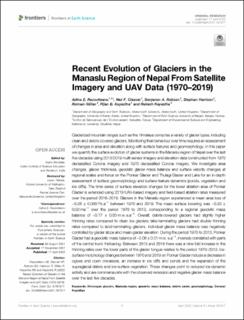| dc.contributor.author | Racoviteanu, Adina E. | |
| dc.contributor.author | Glasser, Neil F. | |
| dc.contributor.author | Robson, Benjamin Aubrey | |
| dc.contributor.author | Harrison, Stephan | |
| dc.contributor.author | Millan, Romain | |
| dc.contributor.author | Kayastha, Rijan B. | |
| dc.contributor.author | Kayastha, Rakesh | |
| dc.date.accessioned | 2023-03-08T12:40:11Z | |
| dc.date.available | 2023-03-08T12:40:11Z | |
| dc.date.created | 2022-06-07T19:32:22Z | |
| dc.date.issued | 2022 | |
| dc.identifier.issn | 2296-6463 | |
| dc.identifier.uri | https://hdl.handle.net/11250/3057076 | |
| dc.description.abstract | Glacierized mountain ranges such as the Himalaya comprise a variety of glacier types, including clean and debris-covered glaciers. Monitoring their behaviour over time requires an assessment of changes in area and elevation along with surface features and geomorphology. In this paper we quantify the surface evolution of glacier systems in the Manaslu region of Nepal over the last five decades using 2013/2019 multi-sensor imagery and elevation data constructed from 1970 declassified Corona imagery and 1970 declassified Corona imagery. We investigate area changes, glacier thickness, geodetic glacier mass balance and surface velocity changes at regional scales and focus on the Ponkar Glacier and Thulagi Glacier and Lake for an in-depth assessment of surface geomorphology and surface feature dynamics (ponds, vegetation and ice cliffs). The time series of surface elevation changes for the lower ablation area of Ponkar Glacier is extended using 2019 UAV-based imagery and field-based ablation rates measured over the period 2016–2019. Glaciers in the Manaslu region experienced a mean area loss of −0.26 ± 0.0001% a−1 between 1970 and 2019. The mean surface lowering was −0.20 ± 0.02 ma−1 over the period 1970 to 2013, corresponding to a regional geodetic mass balance of −0.17 ± 0.03 m w. e.a−1. Overall, debris-covered glaciers had slightly higher thinning rates compared to clean ice glaciers; lake-terminating glaciers had double thinning rates compared to land-terminating glaciers. Individual glacier mass balance was negatively controlled by glacier slope and mean glacier elevation. During the period 1970 to 2013, Ponkar Glacier had a geodetic mass balance of −0.06 ± 0.01 m w. e.a−1, inversely correlated with parts of the central trunk thickening. Between 2013 and 2019 there was a nine-fold increase in the thinning rates over the lower parts of the glacier tongue relative to the period 1970–2013. Ice-surface morphology changes between 1970 and 2019 on Ponkar Glacier include a decrease in ogives and open crevasses, an increase in ice cliffs and ponds and the expansion of the supraglacial debris and ice-surface vegetation. These changes point to reduced ice-dynamic activity and are commensurate with the observed recession and negative glacier mass balance over the last five decades. | en_US |
| dc.language.iso | eng | en_US |
| dc.publisher | Frontiers | en_US |
| dc.rights | Navngivelse 4.0 Internasjonal | * |
| dc.rights.uri | http://creativecommons.org/licenses/by/4.0/deed.no | * |
| dc.title | Recent Evolution of Glaciers in the Manaslu Region of Nepal From Satellite Imagery and UAV Data (1970–2019) | en_US |
| dc.type | Journal article | en_US |
| dc.type | Peer reviewed | en_US |
| dc.description.version | publishedVersion | en_US |
| dc.rights.holder | Copyright 2022 The Author(s) | en_US |
| dc.source.articlenumber | 767317 | en_US |
| cristin.ispublished | true | |
| cristin.fulltext | original | |
| cristin.qualitycode | 1 | |
| dc.identifier.doi | 10.3389/feart.2021.767317 | |
| dc.identifier.cristin | 2030068 | |
| dc.source.journal | Frontiers in Earth Science | en_US |
| dc.identifier.citation | Frontiers in Earth Science. 2022, 9, 767317. | en_US |
| dc.source.volume | 9 | en_US |

